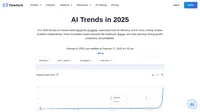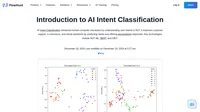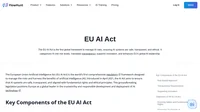AI technology trends refer to the current and emerging advancements and applications in artificial intelligence (AI) that are shaping industries and influencing future technological developments. These trends encompass innovations in machine learning, large language models, multimodal capabilities, and various AI-driven applications across different sectors.
Examples and Use Cases
- Machine Learning: A pivotal trend in AI, machine learning involves algorithms that allow computers to learn from data and improve their performance over time. It is used in predictive analytics, autonomous vehicles, and recommendation systems. For instance, Netflix uses machine learning to suggest content based on user preferences. Cutting-edge advancements in machine learning include reinforcement learning and deep learning, which are being used to improve the efficiency of neural networks and enhance decision-making processes in complex environments.
- Large Language Models (LLMs): These are AI models designed to understand and generate human-like text. Examples include OpenAI’s GPT series and Google’s BERT. Large language models are used in chatbots, virtual assistants, and content creation tools, providing enhanced customer service and automating routine tasks. The evolution of LLMs in 2024 focuses on improving contextual understanding and reducing biases, making them more reliable for various applications from customer support to creative writing.
- Multimodal Capabilities: This trend involves AI models that can process and integrate multiple forms of data, such as text, images, and audio. Multimodal AI is used in applications like video analysis for surveillance, healthcare diagnostics, and interactive virtual assistants. The advancement of multimodal AI is driving the development of more sophisticated systems capable of performing complex tasks that require the simultaneous interpretation of various types of data, such as autonomous driving and advanced robotics.
- Generative AI: A significant trend where AI systems can create new content, including text, images, music, and more. Generative AI is used in creative industries for content creation and in gaming for procedural generation of game environments. Recent developments have seen generative AI contribute to areas such as drug discovery and architectural design, where it can simulate numerous scenarios to optimize outcomes.
- Virtual Assistants: AI-powered tools like Siri, Alexa, and Google Assistant help users perform tasks through voice commands. Virtual assistants are increasingly used in smart homes, customer service, and personal productivity applications. The next generation of virtual assistants is expected to offer more personalized interactions, greater integration with IoT devices, and improved understanding of user intent.
Key Trends to Watch
- Foundation Models: These are large-scale AI models that serve as the base for various applications. Companies like OpenAI and Meta are leading in developing foundation models, which are critical for natural language processing tasks. Foundation models are becoming more accessible and are being fine-tuned for specialized applications across different sectors, enhancing their utility and effectiveness.
- Retrieval Augmented Generation (RAG): This technique combines AI generation with information retrieval to produce more accurate and contextually relevant outputs. RAG is particularly useful in enterprise applications where precision is paramount. It is being leveraged to improve content accuracy in areas such as legal document review and academic research.
- Open Source Models: The development and use of open-source AI models allow broader access and collaboration, enabling more entities to participate in AI innovation without the high costs associated with proprietary models. Open-source initiatives are fostering community-driven progress and innovation in AI, leading to more diverse and inclusive AI solutions.
- Fine-Tuning: The process of refining pre-trained AI models for specific tasks or industries. This trend allows for customization of AI applications to meet niche requirements, enhancing their effectiveness in specific domains. Fine-tuning is essential in fields like healthcare, where AI models need to be adapted to specific medical datasets and terminologies.
- Tech Analytics Predictions: AI-driven analytics are being used to predict industry trends, customer behaviors, and potential market shifts, enabling companies to make informed strategic decisions. Predictive analytics powered by AI is transforming industries by providing insights that drive strategic planning and competitive advantage.
- Multimodal Models: These models can handle diverse data types and are pivotal in applications requiring simultaneous processing of text, images, and audio, such as autonomous vehicles and advanced robotics. The future of multimodal models lies in their ability to facilitate seamless human-machine interactions and enhance decision-making in real-time environments.
Is There an AI Bubble?
Understanding the AI Bubble
The concept of an AI bubble refers to the potential overvaluation of AI technologies and companies, driven by excessive investment and media hype, similar to previous technology bubbles like the dot-com boom. A bubble typically involves inflated expectations that may not align with the actual capabilities and economic value of the technology.
Indicators of an AI Bubble
- Excessive Valuations: High valuations of AI companies, often fueled by venture capital investment, can indicate a bubble if they are not supported by sustainable business models or revenue streams. The rapid influx of investment can lead to unsustainable growth and eventual market corrections.
- Media Hype: The portrayal of AI as a solution to all problems can lead to unrealistic expectations, contributing to speculative investments and market volatility. The media often amplifies breakthroughs without adequately addressing the limitations and challenges associated with AI technologies.
- Speculative Investments: A surge in investments based on future potential rather than current performance can signal a bubble, as investors may pull back once the reality sets in. This speculative fervor can create an unstable market environment prone to abrupt shifts in investor sentiment.
Counterarguments
- Unique Value Proposition: Unlike other bubbles, AI offers a diverse range of applications across industries, from healthcare diagnostics to financial analytics, providing real value and innovation opportunities. The tangible impact of AI on productivity and efficiency counters the notion of it being merely speculative.
- Substantial Investments in Infrastructure: Significant investments in AI infrastructure, such as data centers and research facilities, indicate long-term commitment and potential for sustainable growth. These investments support the scalability and robustness of AI applications, ensuring their viability in the long run.
- Ethical and Regulatory Developments: The establishment of ethical guidelines and regulatory frameworks can stabilize the market by ensuring responsible AI deployment and addressing public concerns about privacy and bias. These measures are critical in fostering trust and mitigating risks associated with AI technologies.
Examples and Insights
- Market Corrections: Fluctuations in AI company valuations may reflect market corrections rather than a burst bubble, leading to more realistic expectations and sustainable growth. As the market matures, it is expected to self-correct, balancing innovation with achievable outcomes.
- AI’s Role in Various Sectors: AI’s integration into critical sectors like finance, healthcare, and manufacturing underscores its potential for creating lasting value beyond speculative hype. Its ability to revolutionize processes and drive efficiency highlights the transformative power of AI across industries.
- AI’s Impact on Employment: While AI may displace certain jobs, it is also expected to create new opportunities, contributing to economic growth and transformation of the workforce. The net effect of AI on employment is likely to be positive, with new roles emerging that leverage AI capabilities.
- Government and Corporate Support: National AI strategies from governments and investments from tech giants like Google and Amazon highlight the strategic importance and longevity of AI technologies. This institutional support underscores the recognition of AI as a cornerstone of future technological advancement.
Introduction to AI Intent Classification
Discover how AI Intent Classification enhances interactions, boosts user satisfaction, and streamlines business operations across various sectors.
Understanding AI Intent Classification
Unlock the potential of AI intent classification with FlowHunt. Enhance chatbot efficiency, customer support, and user experience today!



